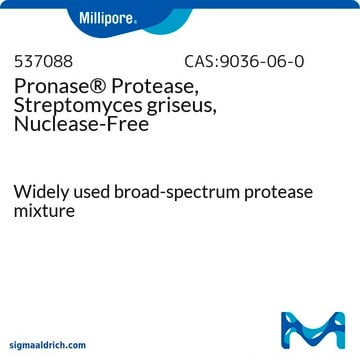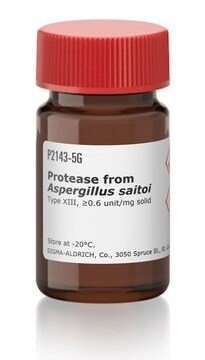53702
Pronase® Protease, Streptomyces griseus
Synonym(s):
Pronase® powder
Sign Into View Organizational & Contract Pricing
All Photos(1)
About This Item
Recommended Products
form
lyophilized
Quality Level
specific activity
≥45,000 proteolytic units/g dry wt
manufacturer/tradename
Calbiochem®
storage condition
OK to freeze
desiccated (hygroscopic)
solubility
water: 10 mg/mL
shipped in
ambient
storage temp.
2-8°C
General description
A non-specific protease liquefies mucins and digests proteins to free amino acids. Can be used to isolate living chondrocytes. Most active at neutral pH, but it is stable over a wide pH and temperature range. Has an optimal pH of 7.5. Note: 1 KU = 1000 units.
A non-specific protease liquefies mucins and digests proteins to free amino acids. Can be used to isolate living chondrocytes. Most active at neutral pH, but stable over wide range of pH and temperature. Note: 1KU = 1000 units.
Note: 1 KU = 1000 units.
Warning
Toxicity: Harmful (C)
Unit Definition
One unit is defined as the amount of enzyme that will liberate a digestion product equivalent to 25 µg of tyrosine per min at 40°C, pH 7.5.
Physical form
Lyophilized from a solution containing calcium acetate as a stabilizer.
Reconstitution
Following reconstitution, store in the refrigerator (4°C). Stock solutions are stable for 24 h at 4°C.
Other Notes
Narahashi, Y., et al. 1968. J. Biochem. 64, 427.
Legal Information
CALBIOCHEM is a registered trademark of Merck KGaA, Darmstadt, Germany
PRONASE is a registered trademark of Merck KGaA, Darmstadt, Germany
Signal Word
Danger
Hazard Statements
Precautionary Statements
Hazard Classifications
Eye Irrit. 2 - Resp. Sens. 1 - Skin Irrit. 2 - STOT SE 3
Target Organs
Respiratory system
Storage Class Code
11 - Combustible Solids
WGK
WGK 2
Certificates of Analysis (COA)
Search for Certificates of Analysis (COA) by entering the products Lot/Batch Number. Lot and Batch Numbers can be found on a product’s label following the words ‘Lot’ or ‘Batch’.
Already Own This Product?
Find documentation for the products that you have recently purchased in the Document Library.
Customers Also Viewed
T E Davis et al.
Infection and immunity, 15(3), 978-987 (1977-03-01)
Enzymes capable of hydrolyzing cell walls of Blastomyces dermatitidis and chemotypes I and II of Histoplasma capsulatum were prepared in the laboratory or obtained from commercial sources. They included chitinases, beta-1,3-glucanases, beta-1,6-glucanase, and Pronase. Monosaccharides and disaccharides of glucose released
Nicole M Templeman et al.
Developmental cell, 54(1), 92-105 (2020-06-17)
Evolutionarily conserved signaling pathways are crucial for adjusting growth, reproduction, and cell maintenance in response to altered environmental conditions or energy balance. However, we have an incomplete understanding of the signaling networks and mechanistic changes that coordinate physiological changes across
Yifei Jiang et al.
Anesthesiology, 125(6), 1159-1170 (2016-09-23)
Exposure to isoflurane increases apoptosis among postnatally generated hippocampal dentate granule cells. These neurons play important roles in cognition and behavior, so their permanent loss could explain deficits after surgical procedures. To determine whether developmental anesthesia exposure leads to persistent
Jun Sunayama et al.
Stem cells (Dayton, Ohio), 28(11), 1930-1939 (2010-09-22)
The molecular signaling pathways orchestrating the biology of cancer stem-like cells (CSLCs), including glioblastoma, remain to be elucidated. We investigated in this study the role of the MEK/extracellular signal-regulated kinase (ERK) pathway in the control of self-renewal and tumorigenicity of
Kenya Terabe et al.
The Journal of biological chemistry, 294(47), 17799-17817 (2019-10-18)
Hyaluronan is a critical component of articular cartilage and partially helps retain aggrecan within the extracellular matrix of this tissue. During osteoarthritis, hyaluronan and aggrecan loss are an early sign of tissue damage. However, our recent attempts to mimic hyaluronan
Our team of scientists has experience in all areas of research including Life Science, Material Science, Chemical Synthesis, Chromatography, Analytical and many others.
Contact Technical Service













